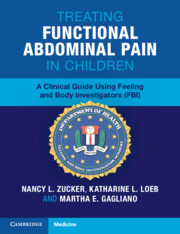 Treating Functional Abdominal Pain in Children
Treating Functional Abdominal Pain in Children from Part I - The Background Science Behind Feeling and Body Investigators
Published online by Cambridge University Press: 18 November 2023
Children with sensory superpowers live life out loud! They have a vivid experience of themselves and the world around them that adds richness to life. Pain sensitivity does not have to be a vulnerability. This chapter is about reframing visceral hypersensitivity as an asset that contributes to three specific superpowers. First, children with visceral sensitivity have spell-binding powers of perception. Because of their history of pain, children may become hyper-vigilant and scared of all the sensations they notice. As they become FBI agents, children learn to harness this perception and use playfulness and curiosity to detect body clues and investigate body mysteries. Second, children with visceral hypersensitivity have awe-inspiring self-awareness. Readers learn about the function, power, and experience of emotions. The intensity with which children feel their bodies runs parallel to strong emotions that can provide vital information to help them get to know and trust themselves. Finally, children with sensory superpowers have faster-than-lightening intuitive decision-making capacities. We explore how sensitivity to physical sensations in the gut can translate to strong feelings that help one “go with their gut” reaction. This chapter links how the tools of the FBI intervention are designed to harness and build each of these superpowers.
To save this book to your Kindle, first ensure [email protected] is added to your Approved Personal Document E-mail List under your Personal Document Settings on the Manage Your Content and Devices page of your Amazon account. Then enter the ‘name’ part of your Kindle email address below. Find out more about saving to your Kindle.
Note you can select to save to either the @free.kindle.com or @kindle.com variations. ‘@free.kindle.com’ emails are free but can only be saved to your device when it is connected to wi-fi. ‘@kindle.com’ emails can be delivered even when you are not connected to wi-fi, but note that service fees apply.
Find out more about the Kindle Personal Document Service.
To save content items to your account, please confirm that you agree to abide by our usage policies. If this is the first time you use this feature, you will be asked to authorise Cambridge Core to connect with your account. Find out more about saving content to Dropbox.
To save content items to your account, please confirm that you agree to abide by our usage policies. If this is the first time you use this feature, you will be asked to authorise Cambridge Core to connect with your account. Find out more about saving content to Google Drive.